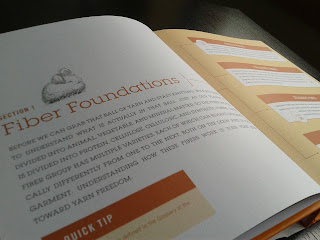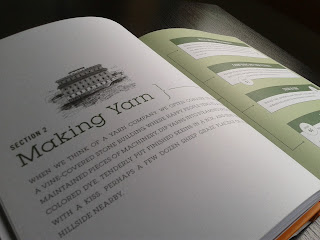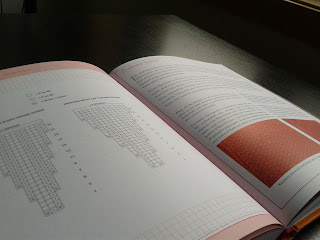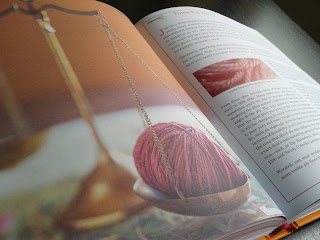
knitting yarn book :: livro sobre fios para tricot...
One of the last books I purchased was "The Knitter's Book of Yarn", written by Clara Parkes.
I always wanted to invest more in the knowledge of the material that I work with every day. I'm curious about the characteristics of the yarn, the little nuances in a type of wool that make all the difference in the finished work, what types of yarn that should be used for a specific work...
My curiosity led me to research: find a book that would explain me more about my beloved yarn.
After my extensive research, I found "The Knitter's Book of Yarn". I read sine reviews online, analyzed the table of contents and ordered it. And thanks goodness I did!

I still haven't finish it, but I read the first few chapters that talk about the basic types of yarn (protein, cellulose, cellulosic, systhetic fibers), explain the general characteristics, how it is done and what can be expected when used in knitting. These early chapters fascinated me, because while I absorbed them, I actually had a few projects in progress using different types of yarn.

I was able to experience in practice what the book was saying to me - as I read I felt those types of yarn, trying to detect the small details mentioned in the book, and trying to compare with each other. It was so much fun!
From these first chapters, I can say that I learned a valuable lesson: to carefully read the labels before buying any product! And I'm sure it also applies to clothing, since by reading the label I know how it was processed, dyed, if it is suitable for my skin type, if it's going to deform in a short period of time, if it scratches or peels, or if it is too heavy for that kind of design.

After these intro chapters, the book provides an explanation for each type of yarn produced. The author covers the yarn from farms, portrays the festivals fiber, how the color is applied to the yarn, and more.

Towards the end of the book, you can learn how to combine different types of yarn. The book concludes with models to try some of the tips that were taught throughout the reading. I have not tried any of these models, but I can say I've applied some of the techniques that I learned.

I think mainly we should look at this book not as an exhaustive manual on the characteristics of yarn, but as a reference.

Therefore, I recommend "The Knitter's Book of Yarn" :)
:: Um dos últimos livros que adquiri foi o "The Knitter's Book of Yarn", escrito pela Clara Parkes.
Sempre quis investir mais no conhecimento do material com que trabalho todos os dias. Tenho curiosidade em relação às características dos fios, as pequenas nuances num tipo de lã que fazem toda a diferença num trabalho terminado, quais os tipos de fio que se devem utilizar para um trabalho em específico...
Esta minha curiosidade levou-me investigação: encontrar um livro que me explicasse mais sobre os meus fios predilectos.
Após uma pesquisa intensiva, encontrei o "The Knitter's Book of Yarn". Li algumas reviews, analisei o índice de conteúdos e encomendei-o. E ainda bem que o fiz!

Ainda não o terminei, mas li os primeiros capítulos que falam sobre os tipos básicos de fio (proteína, celulose, celulósico, fibras sintéticas), explicando as características gerais, como é feito e o que se pode esperar quando os usamos para tricotar. Estes primeiros capítulos fascinaram-me, porque enquanto os absorvia tinha nas agulhas ao meu lado vários projectos, cada um com um tipo de fio diferente.

Pude comprovar na prática o que o livro me ia dizendo - enquanto lia, ia sentindo o tipo de fio, tentava detectar os pequenos detalhes referidos no livro e tentava comparar uns com os outros. Foi muito divertido!
Destes primeiros capítulos, posso dizer que aprendi uma lição valiosa: olhar bem para as etiquetas dos fios antes de os comprar! E tenho a certeza que também vou aplicar esta regra à compra de roupa, uma vez que olhando para a etiqueta, posso saber como foi processada, tingida, se é adequada para o meu tipo de pele, se se deforma em pouco tempo, se arranha ou fica com borboto, ou se é pesada demais para aquele tipo de design.

Depois o livro passa para uma explicação como cada tipo de fio é produzido. A escritora abrange os fios provenientes de quintas, retrata os festivais de fibras, como é que a cor é aplicada ao fio, e muito mais.

Mais para o final do livro, pode-se aprender como se pode conjugar diferentes tipos de fio. O livro é rematado com modelos para experimentarmos algumas das dicas que nos foram sido ensinadas ao longo da leitura. Ainda não experimentei nenhum destes modelos, mas posso dizer que já apliquei algumas técnicas que fui aprendendo.

Acho que principalmente se deve olhar para este livro não como um manual exaustivo sobre as características de fios, mas como uma uma referência.

Posso dizer que recomendo o "The Knitter's Book of Yarn" :)
